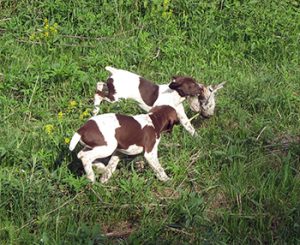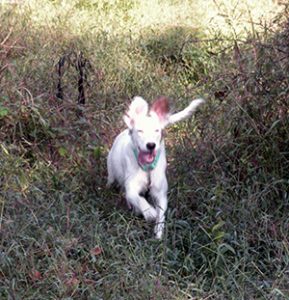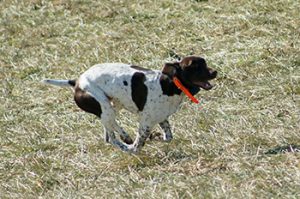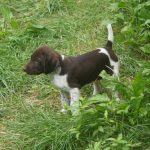Should I Let My Pup Run Without Any Control?
Pointing Dog Pointer
By Bob & Jody Iler
 Many new pointing dog owners wonder how much control they should use with their puppies in the field. If you remember only one thing during the first year of your pup’s development, it should be this: Let the youngster get out and have fun with the least amount of control needed!
Many new pointing dog owners wonder how much control they should use with their puppies in the field. If you remember only one thing during the first year of your pup’s development, it should be this: Let the youngster get out and have fun with the least amount of control needed!
You may be able to tell what your pup’s natural, in-bred range is at a young age. One eight-week-old pup might tear up the field with gusto, while another may be more tentative, cautiously checking things out. One pup will need your reassuring presence as you explore the field together; another may take off without a backward glance. All pups – when given positive encouragement, time, and no pressure – will learn that the field is a fun place to be and represents a special time shared with you.
Genetics, individual temperament, hunting terrain, and age of the pup are all factors that come into play as you develop your pointing dog.
If mom and dad are close-working “versatile breed” hunters, chances are that junior will follow suit. Pups of this nature may naturally quarter and check back, working within shotgun range, as they develop. These types almost seem to self-train and make the job of a first-time pointing dog owner much easier.
But within any pointing breed, and especially among the lines bred for big-running dogs, you’ll get pups that want to get out there and really run! These pups can be more of a challenge when developing them. New owners may panic as the pup takes off and wonder, “Now what?”
Add the pup’s temperament to the mix of possible inherited ranges and the pup starts coming into focus even more. You may have a close-working pup with a lot of drive and zest. You may have a pup that wants to head for the horizon with the same drive and zest. You might have a shy pup that, once in the field, transforms into a bird-crazy machine. You may also have a pup that shows little interest in going too far away from you, with no inclination to explore.
 To further confound you, all these things can change as the pup develops and learns what he’s really all about. We’ve trained field trial caliber pups that did not run very big when they were several months old and later developed tremendous range. We’ve had timid pups that transformed into confident, capable pointing dogs.
To further confound you, all these things can change as the pup develops and learns what he’s really all about. We’ve trained field trial caliber pups that did not run very big when they were several months old and later developed tremendous range. We’ve had timid pups that transformed into confident, capable pointing dogs.
Just like we said in a previous article – that “the point will come” – likewise, what’s inside your budding pup will eventually show itself, with encouragement and no pressure. The trick is to learn to read your pup; this is an art developed by watching your pup for telltale signs as you work with him. He will let you know when he is ready for control work. If he has developed drive in the field, is very bold, and is not paying you any heed, you can begin to add a little control work with the checkcord. The pup has let you know he’s ready, and you’ve been paying attention to the signs. A tucked tail and lackluster enthusiasm is another sign: You may be going too fast.
The type of cover that you work your young pup in makes a big difference. In the beginning, little puppies need easier grounds to run in and build confidence. As they get older, they learn that most open fields are made to stretch out in, and heavy cover and woods generally draws them in closer. In the early months, giving pup his head in different types of cover will help him develop experience and learn where birdy objectives are.
When it comes to training their new pointing dog pups, most folks are eager to do something right away. Armed with collar, lead, long line, and whistle, (and maybe a training book or video) they want to start the “program.” For the retriever or flushing dog pup, this would be all right. For the pointing dog pup, not so much.
Putting a lot of obedience and control into the youngster before he’s had a chance to develop as a pointing dog can inhibit his development. He needs to be a puppy first and foremost: to explore, run, and play; to learn about birds in a positive manner; to flush and chase birds, building enthusiasm and confidence; to learn caution on his own; to begin pointing when he scents the bird; and to give exuberant chase when the bird is flushed. All these things help your pup discover his potential.
If you are whistling constantly to him, hacking him in with a long line, making him “whoa” before he’s learned to love and chase the birds, demanding obedience or performance that he is not ready for, you won’t be training your pup, rather, you’ll be getting in the way of his development.
 You may have heard the old saying, “You can always pull a dog in, but you can’t push him out.” This means that you can always add the control, but first you have to instill the desire and spirit in the pup – or there will be nothing to control.
You may have heard the old saying, “You can always pull a dog in, but you can’t push him out.” This means that you can always add the control, but first you have to instill the desire and spirit in the pup – or there will be nothing to control.
More times than we like to recall, we’ve had young dogs come to the kennel for training that had too much pressure put on them as youngsters by well-meaning owners. Some of these dogs did not like to go to the field, period. Some did not stray far from our sides in the field, afraid to make a “mistake.” Some were bird or gun shy.
In all these instances, our first order of business was to go back to the beginning and let them be puppies all over again. We “de-trained” them; we let them have their heads so that they could rediscover the spirit and enthusiasm within that had been dampened by too much training, too soon.
Pointing Dog Pointers features monthly training tips by Bob and Jody Iler, who own Green Valley Kennels in Dubuque, Iowa. Bob and Jody have trained pointing dogs for over 35 years and have written many articles for The Pointing Dog Journal.





